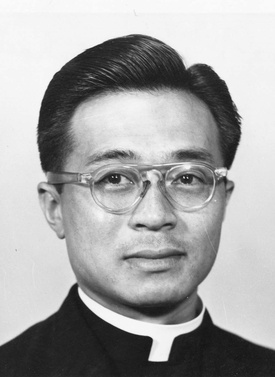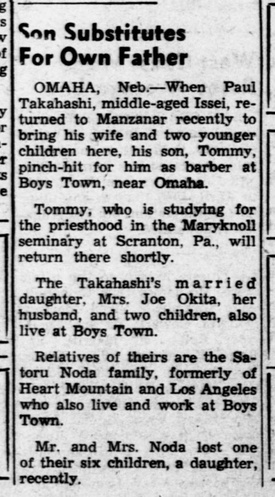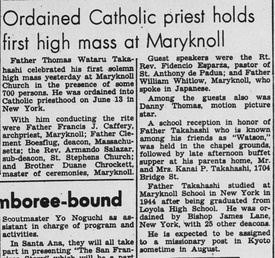Although most of the permanent clergy at the Maryknoll missions did not come out of the Japanese American community, a number of Nikkei clergy, such as Sisters Bernadette and Suzanne, worked among the Japanese American community. One of the first Japanese American Catholics to enter the priesthood was Father Thomas Wataru Takahashi, known also by his friends as “Watson” Takahashi, who built a successful career as a Maryknoll missionary in Los Angeles and in Japan.
Thomas Wataru Takahashi was born on August 3, 1919 in Los Angeles, the son of Japanese immigrants Paul Kanai and Hisayo Takahashi. During his childhood, his mother Hisayo died, and he was raised by his father, the owner of a barber shop in Los Angeles. While Paul Kanai Takahashi was originally a Jodo Shinsho Buddhist, he took the young Thomas to Sunday meetings at the Los Angeles Buddhist Temple. Thomas later recalled that, during these visits, he passed the Maryknoll Church. Along with his sister Toye and brother Joseph, Thomas enrolled in the Maryknoll school, and there developed a strong interest in the Catholic faith.
At a young age, Thomas Takahashi showed promise as both student and community member. At age 8, the young Thomas was one of four Maryknoll students whose essays were printed in the May 23, 1927 issue of the Rafu Shimpo. While at Maryknoll, Takahashi became active in the school’s Boy Scout Troop 145, a troop led by Brother Theophane Walsh. At age 16, Takahashi was nominated with one other scout from Troop 145 to attend the Washington, D.C. National Scout Jamboree.
Takahashi decided to pursue a calling as a priest in the aftermath of a near-death experience in his childhood, a story he later recalled in a January 1965 interview for the Catholic newspaper The Voice. During a pneumonia epidemic in Los Angeles, Takahashi fell ill and was sent to the hospital. As the hospitals were crowded with patients, Takahashi felt he had little chance to live. Wishing to receive communion like his classmates, Takahashi asked his father for his permission to take communion and formally join the Catholic faith. After phoning the Maryknoll mission, a priest, Father Frederick Fitzgerald, swiftly arrived to baptize Takahashi and gave him his first communion. The moment inspired the rest of Takahashi’s family to join the Catholic Church.
Takahashi graduated from Maryknoll school in 1933, along with fellow classmate and future Pacific Citizen editor Harry Honda (for Honda’s own reflection on Takahashi, see his 2012 article on Danny Thomas in the Rafu Shimpo). Takahashi continued his studies at Abraham Lincoln High School, and later transferred to Loyola High School. In November 1940, Thomas served as an usher at his sister Toye’s wedding at the Maryknoll Church. The wedding was officiated by Father John Swift, and Brother Theophane Walsh sang.
Following the bombing of Pearl Harbor and the incarceration of the Japanese American community after February 19, Thomas Takahashi joined his family at Manzanar Concentration Camp, leaving in March, 1942 as part of an initial group that left from the Maryknoll Center. While at Manzanar, Takahashi worked with the Maryknoll Church in camp, where he led catechism classes, organized summer activities for students, and assisted with the boys’ choir. He also served as the editor of the camp’s weekly Catholic newspaper Manza-knoll. He also continued his work with the Boy Scouts as a troop leader for Manzanar’s scouts, and led hikes with his scouts outside of the camp perimeter.
At the same time, Takahashi received his high school diploma in absentia from Loyola High School in Los Angeles in 1944. In July 1944, Takahashi left Manzanar to begin his training with the Maryknoll order at their Vernard Seminary in Pennsylvania. His father Kanai also left Manzanar to take a job as a barber at Boys Town, a Catholic orphanage for boys started by Father Edward Flanagan in Nebraska in 1917, to help pay for Thomas’s training. The rest of Thomas’s family, including his sister Toye and her husband Joe Okita, also moved to Boys Town. Although Thomas remained at Maryknoll Seminary, he made multiple trips to Manzanar in 1945 to help people leave camp.
From 1944 until 1953, Thomas Takahashi trained toward the priesthood at Maryknoll’s Vernard Seminary and Main Seminary in Ossining, New York. According to Harry Honda, Takahashi briefly left the seminary in 1948 because of a malignant tumor in his abdomen. After a successful operation to remove the tumor at Queen of Angels Hospital in Los Angeles, Takahashi returned to the Maryknoll Seminary in Ossining, New York to complete his training.
Upon graduating from the Class of 1953, Father Takahashi was ordained as a priest on June 13, 1953. He then returned to Los Angeles, where he presided over his first mass at the Maryknoll Church on June 26, 1953. In attendance at his mass were numerous Maryknoll fathers, including Fathers Francis Caffrey and Clement Boesflug, and Hollywood film star Danny Thomas. The mass, as with many other events in Father Takahashi’s, appeared in the pages of the Rafu Shimpo. His journey to the priesthood also garnered the attention of Maryknoll Father Albert J. Nevins, leading him published an account of Father Takahashi in his book The Meaning of Maryknoll in 1954.
Soon thereafter, Father Takahashi received his first assignment in August 1953 to work among the Japanese communities in and around Tokyo and Kyoto. After a year of language training in Tokyo, Father Takahashi left for the village of Sonobe, where he catered to the needs of three nearby missions established by Father Edward Barron shortly after the end of the war. Father Takahashi recorded many of his experiences in articles that appeared in Maryknoll’s magazine Field Afar.
In his first article, Father Takahashi described his first days adjusting to life in Sonobe, and at one pointed noted that the locals called for a Shinto priest to ward off evil spirits at their newly-built Catholic Church. Often Father Takahashi laced humor into his anecdotes about his cultural adjustment to Japan, at times noting the challenges facing him as a priest and his joy of working with his parish.

In one moving story, Takahashi recounted the ostracization of a tuberculosis patient in the village of Utsu-mura, the patient’s conversion to Catholicism, and his rehabilitation in a Catholic hospital. In total, he penned six stories for Field Afar about his time in Japan from 1956 to 1957.
Father Takahashi argued that one of the greatest challenges facing missionaries in Japan was the postwar rise of materialism among the Japanese. In an October 1959 interview for the Shin Nichibei, Father Takahashi stated that the postwar initiatives by Catholic missionaries have struggled to find converts due to the wealth of material goods available to the average Japanese citizens.
Likewise, Takahashi confessed that many Japanese saw Catholicism as another attempt by the U.S. to impose Western culture upon Japan, while also pointing out that many Catholic GIs do not follow the Gospel faithfully. Nonetheless, Takahashi stated that many Japanese gladly sent their children to Catholic schools because of their prominence within the community. Surprisingly, Father Takahashi argued the only way the Japanese would accept Catholicism is if a tragedy stripped them of materialism and reminded them of the teachings of the Gospel.
Father Takahashi returned on furlough from his first mission in Summer 1959 to Ossining, New York, in part because of the passing of his father the previous year. In November 1959, Father Takahashi returned to Los Angeles to visit his remaining family and assist with Maryknoll ceremonies. On November 12th, Father Takahashi presided over an award celebration for Troop 145, his former troop, at the Maryknoll Church.
Following a one-year furlough in the United States, during which time he spent some time at the Los Angeles Maryknoll branch, Father Takahashi returned to Japan in 1960, where he presided over the Uji and Tanabe parishes on the outskirts of Kyoto. He again returned to the United States in 1965 to attend the Missioners Conference, and again visited Los Angeles to partake in duties at his former parish.
Upon his return to Japan in 1966, he began work as the director of the Center for Korean Catholics in Kyoto. He forged ties with local Koreans, who, like himself before in the United States, faced discrimination from the majority Japanese population. In 1971, he left his position as director to begin training in English language education, though it is not clear if he ever made professional use of these studies. In 1977, Maryknoll assigned him as pastor of the Ise parish in the town of Mie.
Over the years, Father Takahashi suffered from declining health. In 1988, he underwent medical treatment at Shiga University Hospital for medical treatment, following which he was forced to retire from his work for health reasons. In December 1988, Takahashi returned to the United States for the last time and entered Maryknoll’s St. Teresa Residence, where he died on January 21, 1989.
Father Thomas Takahashi was the very first Japanese American priest to be ordained by the Maryknolls. He was soon joined by another Japanese American, Father Bryce Nishimura, in following the priesthood. Father Takahashi devoted his life to work among ethnic Japanese and Koreans on both sides of the Pacific, and his strong sense of compassion was influenced by both Catholicism and the wartime incarceration.
© 2021 Jonathan van Harmelen








